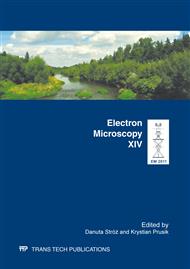p.247
p.251
p.255
p.259
p.263
p.267
p.271
p.275
p.279
Positive Hydrogen Effect in Structure Surface Layers on Ti Alloy
Abstract:
This paper presents the influence hydrogen effect in structure of surface layers on Ti-6Al-4V two-phase titanium alloys. It was described that hydrogen can be used as a temporary alloying element. The paper regarding the HTM - Hydrogen Treatment of Materials as an attractive method for controlling structure and improving final mechanical properties of titanium alloys. Hydrogen treatment consists of the three stages: hydrogenation in hydrogen gas atmosphere (600°C), cyclic heat hydrogen treatment (250°C), dehydrogenation in vacuum (550°C). This treatment uses purposeful, temporary introduction of hydrogen into the alloy to generate defects in its microstructure. Furthermore, it then causes recrystallization of defect microstructure during the dehydrogenation stage to grain refinement. This high-temperature treatment is very efficient for changing the microstructure and mechanical properties of two-phase titanium alloys.
Info:
Periodical:
Pages:
263-266
Citation:
Online since:
March 2012
Authors:
Price:
Сopyright:
© 2012 Trans Tech Publications Ltd. All Rights Reserved
Share:
Citation:


